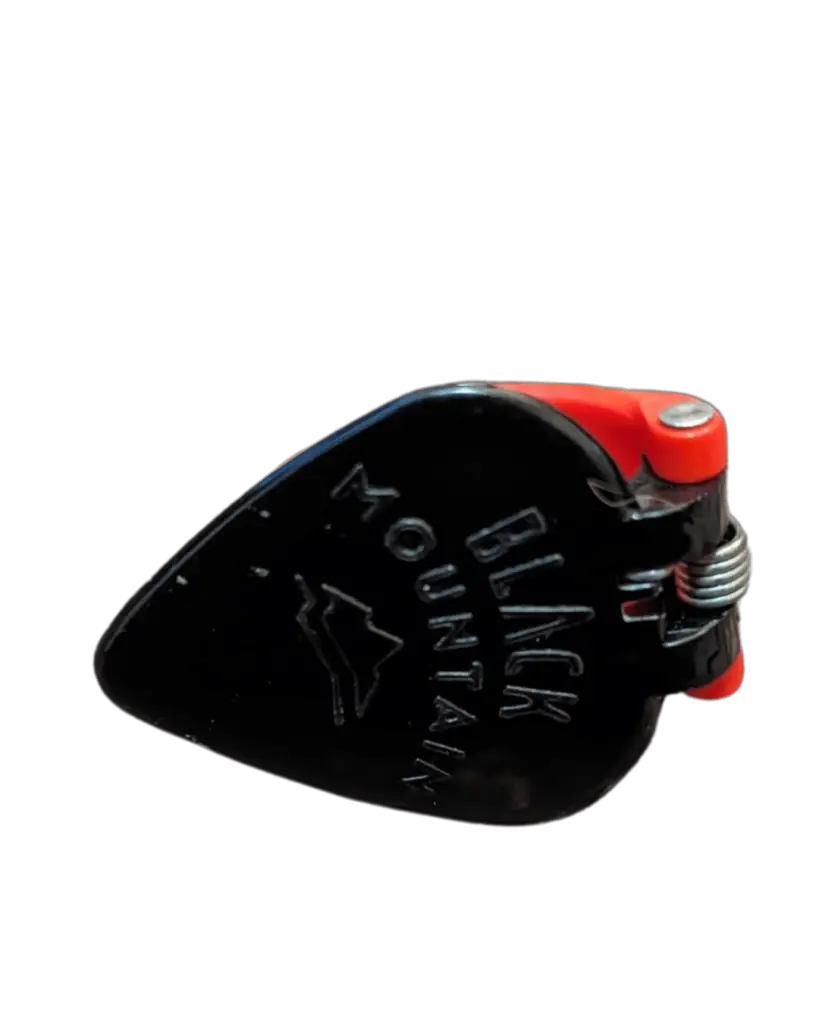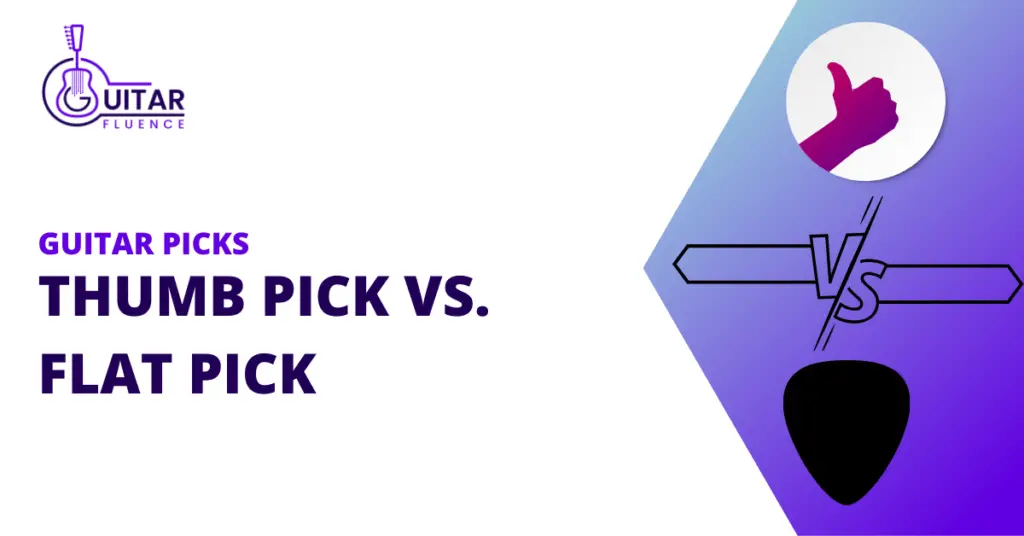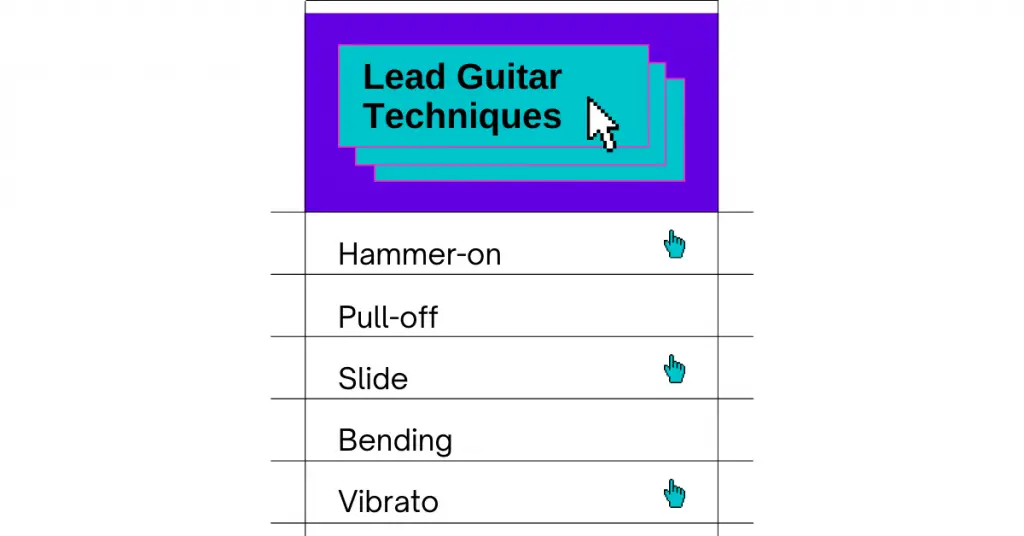Discover the key distinctions between the thumb pick vs. flat pick in this informative article. Uncover the advantages and disadvantages of each pick type, and gain insights into how they impact your guitar playing style and sound.
The main difference is that thumb picks are worn on the thumb and used for fingerstyle playing, while flat picks are held between the fingers and used for strumming or picking individual notes with a flat surface.
Put another way:
Use thumb picks for intricate fingerstyle playing, ideal for genres like country, folk, or classical, and essential for Travis picking.
Opt for flat picks when strumming chords or picking notes with a broader, more even sound, commonly used in all popular genres. Also opt for plat picks when executing shred techniques such as sweep picking and alternate picking.
Table of Contents
Thumb Pick vs. Flat Pick: Main Features
Thumb Pick Overview
A thumb pick is a plectrum designed to be worn on the thumb, featuring a flat or contoured pick extending from the tip
It allows guitarists to use their thumb for picking individual notes or playing bass lines, particularly enhancing fingerstyle techniques like Travis picking. Thumb picks provide a unique tonal quality and are popular in genres such as folk, country, and even classical music.

Travis Picking: This is a fingerstyle guitar technique involving alternating bass notes and melody, often associated with country and folk music. Using a thumb pick enhances Travis picking by providing a distinct bass line, allowing fingers to focus on intricate melody and chord patterns.
PIMA: PIMA represents the fingers used in fingerstyle guitar playing: P for thumb, I for index, M for middle, and A for ring finger. When using a thumb pick, the P refers to the thumb with the pick, allowing fingers I, M, and A to handle melody and chord patterns in fingerstyle playing.
Flat Pick Overview
A flat pick, also known as a plectrum, is a small, flat tool typically made of plastic or other materials. Held between the fingers, it has a pointed or rounded tip for striking the guitar strings.
Flat picks are widely used for strumming chords and picking individual notes with a consistent, even tone. Common in every genre of music, flat picks are a staple in guitar playing.

Strumming: Strumming is a guitar playing technique where a flat pick is used to sweep (strum) across the strings, producing a chordal or rhythmic sound. It’s a fundamental technique for playing chords and accompaniment in most genres, making the flat pick an essential tool for creating a full and vibrant strummed sound.
Alternate Picking: Alternate picking involves using a flat pick to play each note by alternating between downstrokes and upstrokes. This technique enhances speed and precision in playing, commonly used in various music genres with a flat pick for clear and controlled articulation.
Hybrid Picking: This advanced guitar technique involves using a combination of a flat pick and fingers to pluck the strings. With a flat pick held between the thumb and index finger, the remaining fingers can pick or pluck individual notes.
Hybrid picking provides greater versatility, enabling both strumming and intricate fingerstyle playing in guitar music.
Thumb Pick vs. Flat Pick: Pros and Cons
Thumb Pick Pros:
Thumb picks offer several advantages for guitar players:
- Enhanced fingerstlye and pick attack: Thumb picks will, without a doubt, enhance your fingerstyle playing. The thumb pick has a stronger pick attack than the plain flesh of the thumb, and allows for more precise picking.
- Tonal versatility: Thumb picks, paired with the use of other fingers, grant greater tonal versatility.
- Travis picking: Travis picking requires a thumb pick.
- Reduces thumb strain: They may reduce the strain on your thumb, especially during long practice sessions or gigs.
- Thumb picks won’t fall out of your fingers: This is because they’re securely attached to the thumb.
- Comfort and holding the pick: You might like the feel of a thumb pick more than a flat pick.
- Technical freedom: Thumb picks grant greater technical freedom by allowing you access to both a flat pick and your fingers.
- Ideal for certain genres: They’re arguably better for certain genres, such as country and bluegrass.
Thumb Pick Cons:
While thumb picks have their advantages, they also come with certain drawbacks. Here are some cons associated with using thumb picks:
- Learning Curve: Guitarists accustomed to playing with bare fingers or flat picks may find it initially challenging to adapt to the different feel and technique required.
- Limited for Certain Playing Styles: Thumb picks may not be the best choice for certain playing styles, particularly those that heavily rely on fast and precise flatpicking. Styles like rock or metal, where alternate picking and sweep picking are common, may be more challenging with a thumb pick.
- String Noise: Thumb picks, especially if not used with proper technique, can produce more string noise compared to flat picks. This can be particularly noticeable when playing faster passages or intricate arrangements.
- Less Precision in Picking: Some guitarists argue that thumb picks offer less precision compared to flat picks when it comes to picking individual notes.
- Not Ideal for Strumming: Thumb picks are generally not the preferred choice for strumming chords. Flat picks are often more versatile for strumming across multiple strings with a consistent and even attack.
- Dependency on Personal Fit: Finding the right thumb pick that fits comfortably can be a challenge. Thumb picks come in various sizes and shapes, and personal preferences regarding fit can vary from player to player. I recommend the Fred Kelly Bumblebee.
- Potential for Tone Inconsistency: Achieving consistent tone with a thumb pick may require careful attention to technique. Inconsistent angle or pick attack can lead to variations in tone, which may be less noticeable with a flat pick.
It’s important to note that while there are cons associated with thumb picks, they are not necessarily drawbacks for every guitarist.
The suitability of a thumb pick depends on individual playing style, preferences, and the specific requirements of the music being played.
Flat Pick Pros
Thumb picks offer several pros, relative to thumb picks:
- Precise Playing: Flat picks help you hit each string with accuracy. This is a general rule and not a fact.
- Versatile for All Styles: You can play any music style easily with a flat pick.
- Clear Strumming: Strumming chords is clear and smooth with a flat pick.
- Great for Beginners: If you’re starting, a flat pick is simple and easy to use.
- Less String Noise: Flat picks create less extra noise while playing.
- Great for Fast Songs: Perfect for fast-paced songs with quick picking passages.
- Consistent Tone: Get a steady and even tone every time you play with a flat pick.
Flat Pick Cons
Flat picks have their advantages, but you may want or need to opt for a thumb pick. Here are some cons associated with using flat picks:
- Less Fingerstyle Fun: Flat picks aren’t great for playing with just your fingers. Luckily, you can combat this with hybrid picking.
- Not as Warm Tones: They can make your guitar sound a bit less warm.
- Strumming Only So-So: While good for strumming, some find it’s not the best.
- Tricky for Hybrid Styles: If you like mixing styles, flat picks can be a bit tricky.
- Can Slip Away: Sometimes, flat picks may slip from your fingers, unlike a thumb pick, which is secure on your thumb.
- Needs Practice for Precision: Getting really precise might take a bit of practice. Of course, this also applies to the thumb pick.
A world-class flat picker: Molly Tuttle
Molly Tuttle is one of the best modern bluegrass and acoustic guitar players, and her flatpicking skills are ridiculously precise. On top of her amazing technique, she’s a great musician.
A world-class thumb pick user & Travis picker: Chet Atkins
Chet Atkins is one of the best guitar players of all time, and he’s one of the most inspirational thumb pick users.
Learn More
Acoustic Guitar Licks: 5 Easy Licks (Tabs + PDF): You can play all 5 of these licks using a thumb pick or a flat pick.
10 Best String Skipping Exercises: String skipping is a technique that’s especially fun to practice with a thumb pick or a flat pick, and is a necessary technique to learn.
Easy PIMA Guitar Exercises (3 Patterns): Get started with using a thumb pick by practicing these PIMA exercises.



